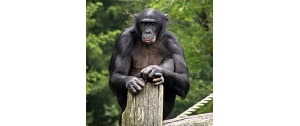

The bonobo ( or ; Pan paniscus), formerly called the pygmy chimpanzee and less often, the dwarf or gracile chimpanzee, is an endangered great ape and one of the two species making up the genus Pan; the other is Pan troglodytes, or the common chimpanzee. Although the name "chimpanzee" is sometimes used to refer to both species together, it is usually understood as referring to the common chimpanzee, whereas Pan paniscus is usually referred to as the bonobo. The bonobo is distinguished by relatively long legs, pink lips, dark face and tail-tuft through adulthood, and parted long hair on its head. The bonobo is found in a 500,000 km2 (190,000 sq mi) area of the Congo Basin in the Democratic Republic of the Congo, Central Africa. The species is omnivorous and inhabits primary and secondary forests, including seasonally inundated swamp forests. Political instability in the region and the timidity of bonobos has meant there has been relatively little field work done observing the species in its natural habitat. Along with the common chimpanzee, the bonobo is the closest extant relative to humans. Because the two species are not proficient swimmers, the formation of the Congo River 1.5–2 million years ago possibly led to the speciation of the bonobo. Bonobos live south of the river, and thereby were separated from the ancestors of the common chimpanzee, which live north of the river. There is no concrete data on population numbers, but the estimate is between 29,500 and 50,000 individuals. The species is listed as Endangered on the IUCN Red List and is threatened by habitat destruction and human population growth and movement, though commercial poaching is the most prominent threat. They typically live 40 years in captivity; their lifespan in the wild is unknown.